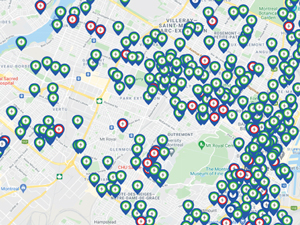 Solutions dealerships can suggest to garage orphans.
Solutions dealerships can suggest to garage orphans.
When selling electric vehicles, dealers repeatedly answer fundamental questions from new buyers: how to charge an EV at home, what model best suits a certain lifestyle, what EV maintenance looks like and more.
But increasingly dealers are being asked: what are my options if I can’t charge my EV at home?
You may be a leading EV dealership, but that doesn’t necessarily make it any easier to talk to buyers who can’t charge at home—commonly referred to as garage orphans. The added challenge is that, for most prospective buyers, their living situation and potential charging solutions won’t be the same.
The best way to talk about EVs when buyers can’t charge at home is to cover the following solutions:
DC Fast Charging (DCFC) stations:
As more and more are being deployed, DCFC stations have become a more popular option for garage orphans because they offer a full charge in as little as 30 minutes. DCFC stations typically operate at power levels of 50kw or 100kw, and offer a similar approach to refuelling a vehicle to gas stations.
In other words, in the same way a driver will make a detour once a week or so to fill up a tank at a gas station, an EV driver will make a detour to a hub of DCFCs to charge their vehicle.
One of our employees is an EV garage orphan, and has relied mainly on curbside charging from the very beginning.
Curbside charging
Curbside Level 2 charging stations are increasingly being deployed on streets by cities and municipalities. These can provide a full charge overnight to a standard EV (typically six to eight hours, depending on the model).
In May 2021, Montreal had 488 Level 2 charging stations operated by Circuit électrique, the majority being curbside charging. In March 2020, there were 422, which is close to a year-over-year increase of approximately 15 per cent.
One of our employees is an EV garage orphan, and has relied mainly on curbside charging from the very beginning.
“I have never had the option to charge at home, so I use curbside charging,” said Jules, accountant at ChargeHub and owner of a Bolt 2019. “Near my apartment, there are four curbside charging stations operated by Circuit électrique, which I’ve been using for over a year now. It costs me 35$ per month for charging sessions.”
Workplace charging
One solution is that you can direct garage orphans to check with their employers on whether workplace charging can be offered. Progressively, thousands of electric vehicle drivers rely on workplace EV chargers to stay fully charged.
Through an initiative created by Natural Resources Canada—the Zero Emission Vehicle Infrastructure Program (ZEVIP)—tenants and businesses are able to offer employees the ability to charge their EVs at the office. Concretely, the ZEVIP invests in the construction of curbside charging stations, at workplaces and in multi-unit residential buildings between 2019 and 2024.
The Program will pay up to 50 per cent of the total project costs to a maximum of $50,000 per charging unit, and up to $5 million per project.
There are also provincial programs such as:
Transition énérgetique Québec rebates: 50 per cent of the total installation costs up to $5,000 per Level 2 charger;
CleanBC rebates for BC Hydro and Fortis BC customers: 50 per cent of the total installation costs up to $2,000 per Level 2 charger;
Electric Vehicles for Municipalities Program in Alberta: for municipalities in Alberta, 50 per cent of the total pre-GST installation costs up to $2,000 per Level 2 charger or DCFC; and
Yukon Level 2 charger rebate: 50 per cent of the total installation costs up to $4,000 per Level 2 charger.
Several municipalities across Canada also offer their own rebates. The ChargeHub team maintains a list of such programs at: https://chargehub.com/en/charging-stations-incentives-in-canada.html
What’s next for buyers without access to home EV charging?
Understanding EV charging can be a make it or break it factor in someone’s decision on whether to purchase an electric vehicle. And you’ve probably noticed that listing these options does not magically generate a full solution. However, it’s a great first step. Having a generous supply of solutions makes EV adoption more inclusive and less painful.
But there’s still plenty of work to be done to make EV charging simple for all buyers, regardless of their living situation.
As EVs win over more Canadians, you can be part of the conversation to bring those solutions forward for your customers, and even more—walk the talk by taking advantage of the rebate programs and offer employees with EVs the possibility to charge at work.










